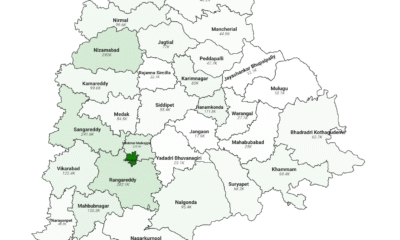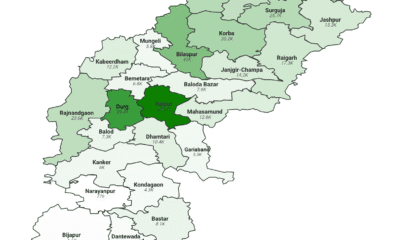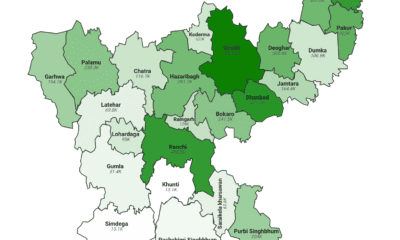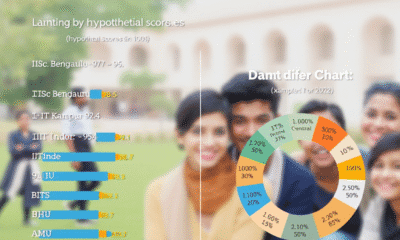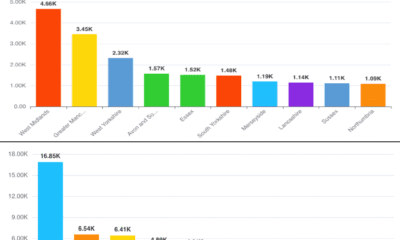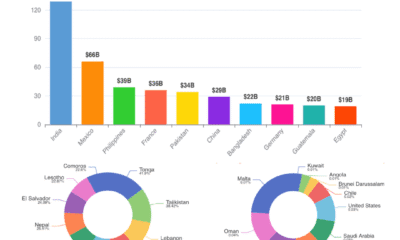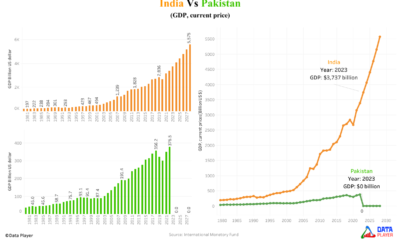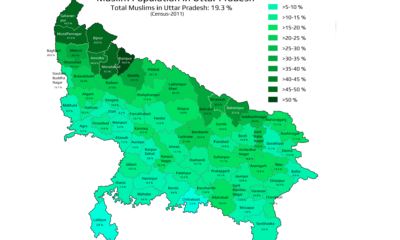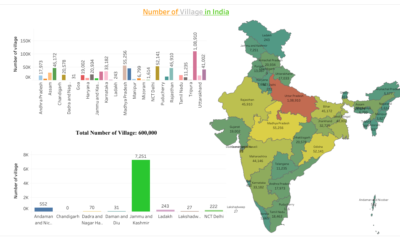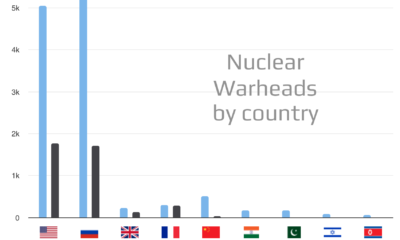
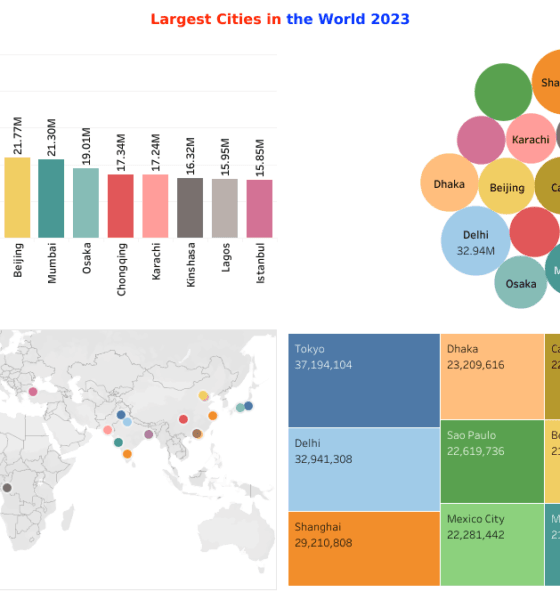
Demographics
Largest Cities in the world by population 2023
Published
2 years agoon
The Outline
- Japan, China and India are the countries that contain 2 such cities which fall under the top 10 most populated cities in the world.
- There is no single European city in the top 10 most populated cities in the world.
- Tokyo is the city and capital of Japan that have similar population as Canada (37 Million).
It is not shocking news that China and India are the most populated countries with 1.45 billion and 1.42 billion respectively. It can be surprising news that the highest populated city is not from China and India but Tokyo is the city in Japan that holds the largest number of inhabitants in the world with 37.2 million. Tokyo and Osaka are the two most populated cities in Japan which secured in top 10 populated cities in the world.
Delhi and Mumbai are the Indian cities and top 10 largest cities in the world. Delhi (India), Dhaka (Bangladesh) and Mumbai (India) are the South Asian cities with 2nd, 4th and 9th largest cities in the world.
There is no European City in the top 10 except Istanbul (15.8 million) which is in 15th position in the world’s largest city. Istanbul is the capital city in Turkey.
The above bar chart is the visual chart that displays top 15 largest cities in the world where Tokyo (37.2 million), Delhi (32.9 million), Shanghai (29.2 million), Dhaka (23.2 million), São Paulo (22.6 million), Mexico City (22.3 million), Cairo (22.2 million), Beijing (21.8 million), Mumbai (21.3 million), Osaka (19 million), Chongqing (17.3 million), Karachi (17.2 million), Kinshasa (16.3 million), Lagos (15.9) and Istanbul (15.8 million).
There are 787 world largest city data represented in the below data table where city name along with its country flag, population of 2023, country code and its ranking in the world. The above bar chart is based on the data table.
Where does the Data fetch from?
Data Source: Data for largest cities in the world are fetched from World Population Review of the year 2023. Several other information are taken from personnel research.
You may like


Muslim Population in Telangana (2025 Update): District-Wise Data, Percentage & Analysis


Muslim Population in Chhattisgarh (2025 Update): District-Wise Data, Percentage & Analysis


Muslim Population in Jharkhand (2025 Update): District-Wise Data, Percentage & Analysis


India University Rankings 2025: Best Colleges You Should Know


Knife Crime in England and Wales: A Deepening Danger We Can’t Ignore


Top Remittance-Receiving Countries in the World
Economy
Global Perception Summit: Who Ranked the Highest in 2024?
Published
2 months agoon
July 26, 2025Excerpt:Switzerland claims the top spot in the 2024 “Best Countries” ranking by public perception, while global economic giants and rising regional players vie for influence in a list shaped by both hard metrics and subjective sentiment.
Switzerland Reigns Supreme
In the U.S. News & World Report Best Countries survey for 2024, where over 17,000 respondents evaluated 87 nations across 73 attributes, Switzerland emerged as the clear favorite. Survey participants praised its robust business environment (#2), exceptional quality of life (#3), commitment to social purpose (#7), and strong cultural influence (#8). Economically, Switzerland ranks third in GDP per capita (US $105,000) and fourth in GNI per capita (US $95,070), underlining why it resonates so strongly on the world stage [1]
Economic Titans and Entrepreneurial Leaders
Despite not topping the list, Japan and the United States secured the second and third places, respectively, buoyed by their sizeable GDPs, innovation ecosystems, and globally recognized brands. Both nations feature in the top five for entrepreneurship, with the U.S. leading in agility and power. High investor confidence and large currency reserves help offset concerns over cost of living and income inequality, demonstrating that sheer economic heft still shapes public perceptions in the survey [2]
Regional Shifts: Rising Powers in the Middle East and Asia
The Middle East and Asia have made notable gains, reflecting targeted investments in tourism, renewable energy, and cultural initiatives. The United Arab Emirates (17th), Qatar (25th), and Saudi Arabia (32nd) are redefining their global images beyond hydrocarbons. In Asia, South Korea (18th), Singapore (14th), and China (16th) leverage technological advances and manufacturing prowess to climb the ranks, signaling a more multipolar perception of excellence.
Global Continent Representation
How are the top 40 distributed by region? Below is a bar chart illustrating the count of best-ranked countries by continent.
The above bar chart illustrates the global continent representation among the top 40 best-ranked countries in the world. Europe leads with 17 countries, making it the most represented continent. Asia follows with 11 countries, while the Americas account for 8. Oceania and Africa each have 2 countries on the list. The chart highlights Europe’s strong global presence and shows a relatively balanced contribution from other continents, reflecting global diversity in top-performing nations.
Complete Top 40 List
The following table presents the complete dataset of the top 40 countries, as determined by the survey respondents. Rankings reflect public perception and must be understood alongside objective thresholds for GDP, tourism, and foreign direct investment inclusion [3]
Top 40 Best Countries in 2024
Perception Breakdown by Region
The above donut chart illustrates the continent share of the top 40 best countries in the world. Europe leads with 42.5%, followed by Asia at 27.5% and the Americas at 20%. Oceania and Africa each contribute 5%. The data highlights Europe’s dominance in global rankings, with Asia also playing a significant role. The chart visually represents how the top 40 countries are distributed across continents, emphasizing regional strengths in global development, governance, and quality of life.
How the Rankings Are Calculated
Respondents rate each country on 73 attributes grouped into 10 categories (e.g., quality of life, power, entrepreneurship). Scores for each attribute are normalized to a 0–100 scale and averaged within categories. Participants also rank category importance, which determines weighting in the final score. Only countries meeting GDP, tourism, and FDI thresholds were eligible for inclusion.
Conclusion
While Switzerland’s blend of economic strength, social well‑being, and cultural vibrancy earned it the top spot, the prominence of traditional powerhouses and emerging players underscores a dynamic global landscape. As public perceptions evolve, so too will the notion of what makes a country truly “the best.”
References
- U.S. News & World Report. (2024). Best Countries Rankings. Available at: https://www.usnews.com/news/best-countries/rankings [Accessed 25 Jul. 2025].
- U.S. News & World Report. (2024). Best Countries Subrankings. Available at: https://www.usnews.com/news/best-countries/rankings [Accessed 25 Jul. 2025].
- VisualCapitalist.com. (2025). Ranked: 40 Best Countries in the World, According to People. Available at: https://www.visualcapitalist.com/ranked-40-best-countries-in-the-world-according-to-people/ [Accessed 24 Jul. 2025].
Demographics
Mapped: Average Working Hours weekly by African Countries in 2024
Published
1 year agoon
July 20, 2024Total Hours:
Female Hours:
Male Hours:
In Africa, the average working hours per week across countries are influenced by various economic, social, and cultural factors, along with differences in gender roles and labor practices.
In Nigeria, the most populous country in Africa rich in oil and diverse ethnic groups, the average workweek is 43.4 hours per week. Men work about 43.7 hours per week, while women work around 42.9 hours per week. This balance reflects the country's economic activities and labor distribution.
In Ethiopia, known for its ancient history and coffee, the average workweek is 30.1 hours per week. Men work around 32.7 hours per week, while women work about 27.2 hours per week, showing a significant difference likely influenced by traditional gender roles and economic structures.
Egypt, home to ancient civilizations and the pyramids, sees an average workweek of 45.5 hours per week. Men work about 46.8 hours per week, whereas women work around 39.4 hours per week, reflecting the economic pressures and societal expectations in northeastern Africa.
In the Democratic Republic of Congo, rich in natural resources and located in central Africa, the average workweek is 34.4 hours per week. Men work about 35.5 hours per week, while women work around 33.4 hours per week, reflecting a modest difference in gender work distribution.
Tanzania, known for Serengeti National Park and Mount Kilimanjaro, has an average workweek of 39.7 hours per week. Men work around 43.3 hours per week, and women work about 35.9 hours per week, showing a gender gap influenced by cultural and economic factors.
In South Africa, located at the southern tip of the continent, the average workweek is 41.7 hours per week. Men work about 43.8 hours per week, while women work around 39.1 hours per week, reflecting the country’s diverse economy and labor practices.
Kenya, famous for its safaris and national parks, has an average workweek of 45.1 hours per week. Men work around 47.9 hours per week, while women work about 42.2 hours per week, highlighting the demanding nature of work in East Africa.
Africa Average Workweek Data
| Country | Avg hour per week (AHW) | Male (AHW) | Female (AHW) |
|---|---|---|---|
| Nigeria | 43.4 | 43.7 | 42.9 |
| Ethiopia | 30.1 | 32.7 | 27.2 |
| Egypt | 45.5 | 46.8 | 39.4 |
| DR Congo | 34.4 | 35.5 | 33.4 |
| Tanzania | 39.7 | 43.3 | 35.9 |
| South Africa | 41.7 | 43.8 | 39.1 |
| Kenya | 45.1 | 47.9 | 42.2 |
| Uganda | 38.7 | 39.8 | 37.5 |
| Sudan | 39.6 | 41.8 | 33 |
| Algeria | 44 | 45.6 | 36 |
| Morocco | 43.9 | 46.6 | 34.4 |
| Angola | 39.3 | 41.2 | 37.4 |
| Ghana | 31.9 | 33.8 | 29.8 |
| Mozambique | 29.4 | 33.6 | 25.4 |
| Madagascar | 31.5 | 33.5 | 29.4 |
| Côte d'Ivoire | 44 | 46.3 | 41 |
| Cameroon | 42.5 | 44.6 | 40.1 |
| Niger | 38.9 | 42.8 | 33.4 |
| Mali | 42.4 | 46.4 | 36 |
| Burkina Faso | 43.4 | 46.4 | 39.8 |
| Malawi | 30.2 | 33.6 | 26.5 |
| Zambia | 42.4 | 44.5 | 39.8 |
| Chad | 40.4 | 42 | 38.2 |
| Somalia | 29.6 | 30.5 | 27.4 |
| Senegal | 44.2 | 48.3 | 37.7 |
| Zimbabwe | 37.1 | 40.5 | 33.6 |
| Guinea | 38.1 | 40.2 | 34.9 |
| Rwanda | 29.9 | 31.9 | 27.6 |
| Benin | 38.9 | 41.4 | 36 |
| Burundi | 39.7 | 41 | 38.4 |
| Tunisia | 43.6 | 44.4 | 41.2 |
| South Sudan | 40.1 | 43.7 | 36.5 |
| Togo | 43.4 | 45.1 | 41.5 |
| Sierra Leone | 42.6 | 44.8 | 40.3 |
| Libya | 44.8 | 46.9 | 40.7 |
| Congo | 47.9 | 48.3 | 47.5 |
| Central African Republic | 39.6 | 42 | 36.7 |
| Liberia | 48 | 49.6 | 46.2 |
| Mauritania | 38.5 | 38.9 | 37.5 |
| Eritrea | 35.3 | 37.7 | 32.5 |
| Gambia | 37.7 | 43.9 | 30.9 |
| Botswana | 43.7 | 46 | 41 |
| Namibia | 42.9 | 44.9 | 40.9 |
| Gabon | 42.3 | 44 | 39.1 |
| Lesotho | 49.5 | 51 | 47.6 |
| Guinea-Bissau | 36.4 | 39 | 33.1 |
| Equatorial Guinea | 41.6 | 43.7 | 38.7 |
| Mauritius | 39.5 | 40.5 | 37.9 |
| Eswatini | 44 | 46.8 | 40.7 |
| Djibouti | 30.6 | 31.7 | 27.5 |
| Comoros | 36.8 | 38.2 | 34.3 |
| Cabo Verde | 42.9 | 44.1 | 41.5 |
| Sao Tome & Principe | 41.4 | 44 | 35.9 |
| Seychelles |
AHW is an abbreviation for Average Hour per Week.
In Uganda, known for its diverse wildlife and Lake Victoria, the average workweek is 38.7 hours per week. Men work around 39.8 hours per week, and women work about 37.5 hours per week, showing relatively balanced gender participation in the workforce.
Sudan, a northeastern African country with a rich history, has an average workweek of 39.6 hours per week. Men work about 41.8 hours per week, while women work around 33 hours per week, reflecting significant gender differences in work hours.
Algeria, the largest country in Africa by land area, has an average workweek of 44 hours per week. Men work about 45.6 hours per week, whereas women work around 36 hours per week, showing a notable gender disparity influenced by cultural norms.
In Morocco, known for its rich cultural heritage and historic cities, the average workweek is 43.9 hours per week. Men work around 46.6 hours per week, while women work about 34.4 hours per week, highlighting significant gender differences in work hours.
Angola, located in southern Africa and rich in natural resources like oil and diamonds, has an average workweek of 39.3 hours per week. Men work around 41.2 hours per week, while women work about 37.4 hours per week.
In Ghana, known for its gold resources and vibrant culture, the average workweek is 31.9 hours per week. Men work about 33.8 hours per week, and women work around 29.8 hours per week, showing a smaller gender gap compared to other countries.
Mozambique, with its beautiful coastline and marine life, has an average workweek of 29.4 hours per week. Men work around 33.6 hours per week, while women work about 25.4 hours per week, showing one of the larger gender gaps in working hours.
In Madagascar, known for its unique biodiversity, the average workweek is 31.5 hours per week. Men work about 33.5 hours per week, while women work around 29.4 hours per week, showing a moderate gender difference.
Côte d'Ivoire, a West African country known for cocoa production, has an average workweek of 44 hours per week. Men work about 46.3 hours per week, whereas women work around 41 hours per week, reflecting high work demands in agriculture and trade.
In Cameroon, with diverse landscapes and cultural heritage, the average workweek is 42.5 hours per week. Men work around 44.6 hours per week, while women work about 40.1 hours per week.
Niger, known for its desert landscapes and rich cultural traditions, has an average workweek of 38.9 hours per week. Men work around 42.8 hours per week, while women work about 33.4 hours per week, reflecting traditional gender roles.
In Mali, known for its music and historical sites, the average workweek is 42.4 hours per week. Men work around 46.4 hours per week, whereas women work about 36 hours per week, indicating significant gender differences.
Burkina Faso, known for its vibrant arts scene and cultural festivals, has an average workweek of 43.4 hours per week. Men work around 46.4 hours per week, while women work about 39.8 hours per week, highlighting the gender gap.
In Malawi, known for its lake and friendly people, the average workweek is 30.2 hours per week. Men work around 33.6 hours per week, while women work about 26.5 hours per week, showing a large gender difference in work hours.
Zambia, known for its natural beauty and Victoria Falls, has an average workweek of 42.4 hours per week. Men work around 44.5 hours per week, while women work about 39.8 hours per week.
In Chad, known for its desert landscapes, the average workweek is 40.4 hours per week. Men work about 42 hours per week, whereas women work around 38.2 hours per week.
Somalia, located in the Horn of Africa, has an average workweek of 29.6 hours per week. Men work around 30.5 hours per week, while women work about 27.4 hours per week, reflecting economic challenges and traditional roles.
In Senegal, known for its music and vibrant cultural festivals, the average workweek is 44.2 hours per week. Men work around 48.3 hours per week, while women work about 37.7 hours per week, highlighting significant gender differences.
Zimbabwe, known for Victoria Falls and diverse wildlife, has an average workweek of 37.1 hours per week. Men work around 40.5 hours per week, while women work about 33.6 hours per week.
In Guinea, known for its natural resources and musical heritage, the average workweek is 38.1 hours per week. Men work around 40.2 hours per week, while women work about 34.9 hours per week.
Rwanda, known for its mountainous landscape and wildlife, has an average workweek of 29.9 hours per week. Men work around 31.9 hours per week, while women work about 27.6 hours per week, reflecting balanced gender participation.
In Benin, known for its rich history and cultural heritage, the average workweek is 38.9 hours per week. Men work around 41.4 hours per week, while women work about 36 hours per week.
Burundi, known for its hills and tea plantations, has an average workweek of 39.7 hours per week. Men work around 41 hours per week, while women work about 38.4 hours per week.
In Tunisia, known for its Mediterranean coastline and ancient ruins, the average workweek is 43.6 hours per week. Men work around 44.4 hours per week, while women work about 41.2 hours per week.
South Sudan, the youngest country in the world, has an average workweek of 40.1 hours per week. Men work around 43.7 hours per week, while women work about 36.5 hours per week.
In Togo, known for its palm-lined beaches and hilltop villages, the average workweek is 43.4 hours per week. Men work around 45.1 hours per week, while women work about 41.5 hours per week.
Sierra Leone, known for its tropical rainforest and coastline, has an average workweek of 42.6 hours per week. Men work around 44.8 hours per week, while women work about 40.3 hours per week.
In Libya, with its vast deserts and rich history, the average workweek is 44.8 hours per week. Men work around 46.9 hours per week, while women work about 40.7 hours per week.
Congo, known for its rainforests and diverse wildlife, has an average workweek of 47.9 hours per week. Men work around 48.3 hours per week, while women work about 47.5 hours per week, reflecting high labor demands.
In the Central African Republic, known for its diverse wildlife and cultures, the average workweek is 39.6 hours per week. Men work around 42 hours per week, while women work about 36.7 hours per week.
Liberia, known for its history and beautiful coastline, has an average workweek of 48 hours per week. Men work around 49.6 hours per week, while women work about 46.2 hours per week.
Mauritania, with its vast deserts and rich cultural traditions, has an average workweek of 38.5 hours per week. Men work around 38.9 hours per week, while women work about 37.5 hours per week.
In Eritrea, known for its Red Sea coastline and history, the average workweek is 35.3 hours per week. Men work around 37.7 hours per week, while women work about 32.5 hours per week.
Gambia, known for its river and cultural heritage, has an average workweek of 37.7 hours per week. Men work around 43.9 hours per week, while women work about 30.9 hours per week.
In Botswana, known for its wildlife and Okavango Delta, the average workweek is 43.7 hours per week. Men work around 46 hours per week, while women work about 41 hours per week.
Namibia, known for its Namib Desert and diverse wildlife, has an average workweek of 42.9 hours per week. Men work around 44.9 hours per week, while women work about 40.9 hours per week.
In Gabon, with its rich biodiversity and oil resources, the average workweek is 42.3 hours per week. Men work around 44 hours per week, while women work about 39.1 hours per week.
Lesotho, known for its high altitude and mountainous terrain, has the highest average workweek of 49.5 hours per week. Men work around 51 hours per week, while women work about 47.6 hours per week.
In Guinea-Bissau, known for its national parks and diverse wildlife, the average workweek is 36.4 hours per week. Men work around 39 hours per week, while women work about 33.1 hours per week.
Equatorial Guinea, with significant oil reserves and a unique cultural heritage, has an average workweek of 41.6 hours per week. Men work around 43.7 hours per week, while women work about 38.7 hours per week.
In Mauritius, known for its beaches and diverse cultures, the average workweek is 39.5 hours per week. Men work around 40.5 hours per week, while women work about 37.9 hours per week.
Eswatini, known for its nature reserves and culture, has an average workweek of 44 hours per week. Men work around 46.8 hours per week, while women work about 40.7 hours per week.
Djibouti, known for its strategic location and port, has an average workweek of 30.6 hours per week. Men work around 31.7 hours per week, while women work about 27.5 hours per week.
In Comoros, known for its volcanic islands and culture, the average workweek is 36.8 hours per week. Men work around 38.2 hours per week, while women work about 34.3 hours per week.
Cabo Verde, known for its Creole culture, has an average workweek of 42.9 hours per week. Men work around 44.1 hours per week, while women work about 41.5 hours per week.
In São Tomé and Príncipe, known for its biodiversity and coffee, the average workweek is 41.4 hours per week. Men work around 44 hours per week, while women work about 35.9 hours per week.
Lastly, Seychelles, known for its beaches and marine life, does not have available data for average work hours per week, reflecting its unique economic and labor conditions.
Overall, these differences in average work hours per week across African countries are shaped by a blend of economic demands, cultural norms, and gender roles, with significant variations between men and women’s work hours highlighting the impact of traditional and economic factors.
Information
Copyright: © 2024 Data Player
*Note: Hover or click on country's region to get full details. A box with details will appear a little bit down the map.
Data source: worldpopulationreview
This webpage provides information on Avg. Working Hours per Week in South Asian Countries and uses various technologies for its functionality.
The following tools and technologies were used:
* HTML and CSS for the webpage structure and styling
* JavaScript for interactive features
* External data sources for statistics
Demographics
Mapped: Average Working Hours weekly by South Asian Countries in 2024
Published
1 year agoon
July 19, 2024Country
In South Asia, the average number of hours people work each week varies greatly due to a combination of economic conditions, cultural norms, labor laws, and gender roles.
In India, the average workweek is 46 hours. The economy is diverse, with a significant portion of the workforce in the informal sector, leading to longer working hours. Men work about 49.9 hours per week, while women work around 36 hours. Traditional views that men are the primary breadwinners mean men often work longer hours, while women balance household responsibilities with their jobs, resulting in shorter official working hours but significant unpaid labor at home.
In Pakistan, the average workweek is 46.6 hours. Similar to India, a large informal sector results in longer working hours. Men work about 50.3 hours per week, whereas women work around 34.2 hours due to domestic responsibilities and societal norms limiting their workforce participation.
In Bangladesh, the average workweek is 45.8 hours. The growing economy, especially in the garment industry, necessitates long hours. Men work about 49.9 hours per week, and women work around 36.9 hours, balancing work with household duties, leading to shorter official working hours.
In Nepal, the average workweek is 39.7 hours. The mixed economy, with a significant agricultural component, results in varied working hours. Men work around 42.6 hours per week, while women work about 34.7 hours, often engaging in considerable unpaid work at home.
South Asia Average Workweek Data
| Country | Avg hour per week (AHW) | Male (AHW) | Female (AHW) |
|---|---|---|---|
| India | 46 | 49.9 | 36 |
| Pakistan | 46.6 | 50.3 | 34.2 |
| Bangladesh | 45.8 | 49.9 | 36.9 |
| Nepal | 39.7 | 42.6 | 34.7 |
| Bhutan | 54.3 | 55 | 53.5 |
| Maldives | 45.2 | 48.9 | 35.8 |
| Afghanistan | 38.3 | 39.6 | 15.8 |
| Sri Lanka | 41.2 | 43.6 | 36.2 |
AHW is an abbreviation for Average Hour per Week.
Bhutan stands out with the highest average workweek of 54.3 hours, reflecting greater gender equality and cultural acceptance of long work hours. Men work about 55 hours per week, and women work around 53.5 hours.
In the Maldives, the average workweek is 45.2 hours. The tourism-driven economy with seasonal fluctuations affects working hours, with men working about 48.9 hours per week during peak seasons. Women work around 35.8 hours due to traditional roles and domestic responsibilities.
In Afghanistan, the average workweek is 38.3 hours. The war-torn economy and many people engaged in informal work see men working about 39.6 hours per week. Strict cultural norms heavily restrict women’s participation in the workforce, resulting in very low working hours for women, around 15.8 hours.
In Sri Lanka, the average workweek is 41.2 hours. The diverse economy leads to varying working hours across different sectors. Men work about 43.6 hours per week, while women work around 36.2 hours, performing a significant amount of unpaid domestic work.
Overall, in South Asian countries, economic conditions, the prevalence of informal sectors, cultural expectations, and the enforcement of labor laws play crucial roles in determining working hours. Traditional gender roles typically see men working longer hours outside the home, while women balance official work with substantial unpaid labor at home, leading to notable gender disparities in workforce participation.
Information
Copyright: © 2024 Data Player
*Note: Hover or click on country’s region to get full details. A box with details will appear a little bit down the map.
Data source: worldpopulationreview
This webpage provides information on Avg. Working Hours per Week in South Asian Countries and uses various technologies for its functionality.
The following tools and technologies were used:
* HTML and CSS for the webpage structure and styling
* JavaScript for interactive features
* External data sources for statistics

Muslim Population in Goa (2025 Update): District-Wise Data, Percentage & Analysis

Muslim Population in Telangana (2025 Update): District-Wise Data, Percentage & Analysis

Muslim Population in Karnataka (2025 Update): District-Wise Data, Percentage & Analysis

Trump’s 2025 Tariffs on India Explained: Full List, Dates, Products, and 50% Duty Impact

Muslim Population in Odisha (2025 Update): District-Wise Data, Percentage & Analysis

Muslim Population in Goa (2025 Update): District-Wise Data, Percentage & Analysis

Muslim Population in Telangana (2025 Update): District-Wise Data, Percentage & Analysis

Muslim Population in Karnataka (2025 Update): District-Wise Data, Percentage & Analysis
Trending

 Economy2 years ago
Economy2 years agoWhy Pakistan’s economy is drowning while India’s economy is touching the sky

 Religion1 year ago
Religion1 year agoMapped: What are the muslims population in Uttar Pradesh | State of India

 Technology2 years ago
Technology2 years agoHighest number of software developers by country in the world 2023 by GitHub | Data Player

 Demographics1 year ago
Demographics1 year agoMapped: Average Working Hours by European Countries in 2024

 Demographics2 years ago
Demographics2 years agoWhat are the Number of Villages in India by its State and Union Territory

 Superpower countries1 year ago
Superpower countries1 year agoGlobal Nuclear Warhead Distribution by Nation 2024

 Demographics2 years ago
Demographics2 years agoMassive population size by Indian states 2023

 Religion1 year ago
Religion1 year agoMapped: What is Muslim Population in West Bengal by District wise 2011
